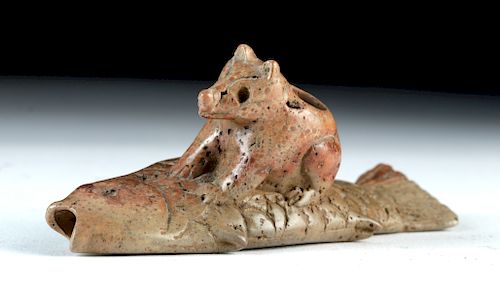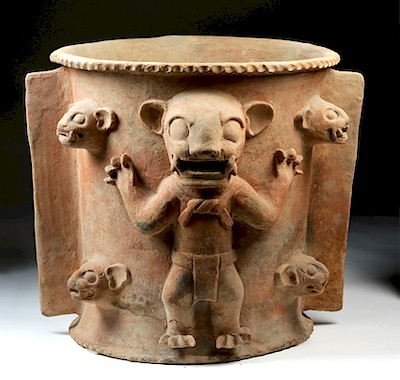Native American Hopewell Pipe - Raccoon & Fish
Lot 160a
About Seller
Artemis Fine Arts
686 S Taylor Ave, Ste 106
Louisville, CO 80027
United States
Selling antiquities, ancient and ethnographic art online since 1993, Artemis Gallery specializes in Classical Antiquities (Egyptian, Greek, Roman, Near Eastern), Asian, Pre-Columbian, African / Tribal / Oceanographic art. Our extensive inventory includes pottery, stone, metal, wood, glass and textil...Read more
Estimate:
$1,000 - $1,500
Absentee vs Live bid
Two ways to bid:
- Leave a max absentee bid and the platform will bid on your behalf up to your maximum bid during the live auction.
- Bid live during the auction and your bids will be submitted real-time to the auctioneer.
Bid Increments
| Price | Bid Increment |
|---|---|
| $0 | $25 |
| $300 | $50 |
| $1,000 | $100 |
| $2,000 | $250 |
| $5,000 | $500 |
| $10,000 | $1,000 |
| $20,000 | $2,500 |
| $50,000 | $5,000 |
| $100,000 | $10,000 |
| $200,000 | $20,000 |
About Auction
By Artemis Fine Arts
Dec 6, 2018
Set Reminder
2018-12-06 10:00:00
2018-12-06 10:00:00
America/New_York
Bidsquare
Bidsquare : DAY 2 : Pre-Columbian, Ethnographic & Fine Art
https://www.bidsquare.com/auctions/artemis-gallery/day-2-pre-columbian-ethnographic-fine-art-3699
Day 2 of an important 2-dy auction featuring ancient and ethnographic art from around the world. Today's sale will feature Pre-Columbian, Native American, African / Tribal, Ethnographic, Spanish Colonial, Fine Art, much more. Artemis Fine Arts info@artemisfinearts.com
Day 2 of an important 2-dy auction featuring ancient and ethnographic art from around the world. Today's sale will feature Pre-Columbian, Native American, African / Tribal, Ethnographic, Spanish Colonial, Fine Art, much more. Artemis Fine Arts info@artemisfinearts.com
- Lot Description
Native American, midwestern United States (Ohio and surrounding area), early Hopewell culture, ca. 100 BCE to 400 CE. One of my favorites! Made from beautiful red-grey soapstone, colored by iron oxide inclusions, this pipe is in the form of a large fish lying on its side with a small raccoon perched on its back. The raccoon's back forms the chamber, while the mouth of the fish is the mouth of the pipe. Like most Hopewell pipes, the smoker would be looking directly into the eyes of the animal as they used it, forming a connection between the human and animal world. Many of these pipes were ritually destroyed, so it is fantastic to find an intact example like this one. Size: 1.4" L x 3.35" W x 1.25" H (3.6 cm x 8.5 cm x 3.2 cm)
This type of pipe is a rare effigy form, which often featured animal figures. The earliest evidence we have for the use of tobacco in this area comes from ca. 100 to 200 CE; in addition to tobacco, and often prior to it, we know from ethnohistorical accounts that people smoked a variety of other plants, including dogwood, juniper, sumac, and bearberry. These pipes were not just made for the simple act of smoking; they seem to have had a strong religious component as well, and various archaeological sites from the period, including the Hopewell Mound sites, have the remains of hundreds of destroyed platform pipes, including effigy ones like this. Others were buried with their owners individually. Effigy platform pipes are believed to be totemic animals or spirits from Native cosmology.
Provenance: private southern California, USA collection, acquired in the 1970s to mid-1980s
All items legal to buy/sell under U.S. Statute covering cultural patrimony Code 2600, CHAPTER 14, and are guaranteed to be as described or your money back.
A Certificate of Authenticity will accompany all winning bids.
We ship worldwide and handle all shipping in-house for your convenience.
#140844Intact. Light surface wear commensurate with age. Some smoothing to form from age and handling.Condition
- Shipping Info
-
All shipping is handled in-house for your convenience. Your invoice from Artemis Gallery will include shipping calculation instructions. If in doubt, please inquire BEFORE bidding for estimated shipping costs for individual items.
-
- Buyer's Premium



 EUR
EUR CAD
CAD AUD
AUD GBP
GBP MXN
MXN HKD
HKD CNY
CNY MYR
MYR SEK
SEK SGD
SGD CHF
CHF THB
THB















